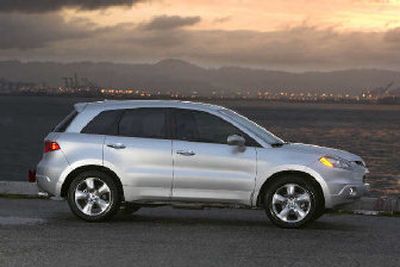RDX handles the winding road

Come August, the hot setup in the Acura family will be a four-cylinder SUV.
How likely is that?
Technically, the rig in question is a crossover - but why split hairs? The all-new RDX is an upright, all-wheel-drive compact CUV powered by a turbocharged 2.3-liter four that makes 240 horsepower and 260 foot-pounds of torque.
That’s more torque than any other vehicle in the Acura family (and let’s not forget that torque is what produces acceleration); it’s even more than that found in its chief rival, BMW’s X3, which gets its power from a 3.0-liter inline six.
Acura will target young, urban males with the RDX, whose low-$30,000s price tag belies its utility, sophistication and dynamic personality. Its upscale cabin will impress the most demanding maiden, while its cargo hold will accommodate two 19-inch mountain bikes with front seats folded.
And when a fellow hankers for some winding-roads action, the RDX is a more-than-willing playmate.
Nominally a five-passenger vehicle, the RDX will comfortably accommodate four adults, although “comfort” understates the case; Acura appears to have expended as much effort on luxury and safety as on performance and safety.
Uplevel materials flood the quiet and elegant cabin, switchgear operates with creamy efficiency, seats support and embrace, and interior surfaces please the eye and the touch.
A 360-watt, seven-speaker sound system with multi-format six-disc changer is standard. XM Satellite Radio and an MP3 input jack accommodates iPods and other digital players.
The computer revolution has impacted the automobile as much as it has the desktop and the RDX carries a host of microchip-enabled technologies.
Chief among them is Acura’s Super-Handling All-wheel Drive system, which dynamically distributes torque front to rear and side-to-side along the rear transaxle, maximizing traction for both foul weather and performance purposes.
SH-AWD incorporates yaw control to reduce understeer, enhance steering accuracy and boost cornering power. Vehicle Stability Assist and traction control increase grip and vehicle control and the standard anti-lock braking system includes electronic brakeforce distribution and brake assist.
A full set of airbags, includes side-impact and curtain-style bags.
The RDX also employ’s Honda/Acura’s new Advanced Compatibility Engineering (ACE), which directs the energy of an impact away from the passenger cabin during a crash.
At the heart of the matter is a powerplant that showcases Honda/Acura’s penchant for engineering.
Taking a page from the diesel industry, engineers designed a variable-flow turbocharger that works in tandem with Honda/Acura’s variable-valve technology to produce a surprisingly broad torque band.
Turbo-lag and weak low-end torque are typically the twin Achilles heels of turbocharging; Acura’s solution overcomes both.
At the RDX launch in San Francisco - the kind of urban environment where Acura expects the RDX to find its audience - the RDX squirted deftly through city traffic without a hint of lag; across the Golden Gate Bridge and out on the two-lane asphalt of coastal Marin County, the engine showed the range of its power band. At higher speeds, the turbo shifts into low-pressure mode and acceleration builds with satisfying urgency.
The engine is paired with Acura’s excellent five-speed automatic, which has a sport-shift mode with steering-wheel-mounted paddles.
As good as it is in its basic form, the RDX can be gussied up with a variety of slick options, including voice-activated navigation and a superb 410-watt DVC-A audio system.
I suspect the RDX will be a hit not only with the target market, but also with women and older buyers. It’s good enough to change the face of the entry-level CUV segment.